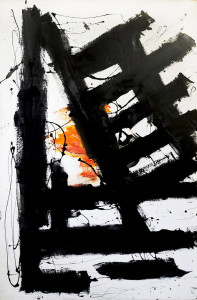Opening Reception: Thursday, April 5th 5-7 pm
Exhibition runs through Friday May 11th
52 East 76th Street
New York, New York 10021
For additional information please contact the gallery (212) 439-6425, katherine@borghi.org.
Gallery hours: Tuesday-Saturday 10 am to 5 pm.
follow us @markborghi
MICHAEL WEST: The Black and White Paintings
April 5, 2018– May 11, 2018
-

The Passover, 1974, oil on canvas, 76 x 50 inches, signed a dated verso
Mark Borghi Fine Art is proud to present Michael West: The Black and White Paintings at its New York gallery. The exhibition will highlight the artist’s signature use of gesture and force demonstrated in her works from the 1950s to the 1970s. As an abstract expressionist, West often used hard edged and bold brushstrokes in her paintings. Economic in their mark making, her paintings exude a powerful hand and active mind.
Born as Corinne Michelle West, Michael West (1908-1991) took classes with Hans Hofmann along with Betty Parsons and Louise Nevelson. In 1932, she befriended Arshile Gorky, who introduced her to European Surrealism and existential theories, which later had great impact on her artistic philosophy. With Gorky, West further came up with a masculine nom de brass “Michael West” in the late 1930s to shift the audience’s attention to the merit of her work, free from the bias of her gender.
From the 1930s to the mid-1940s, West’s paintings reflect her embrace of Cubism reminiscent of Picasso and Juan Gris. Her reading of Henri Bergson’s theory of “living energy” is demonstrated in her paintings with active forms covering the entire picture plane, as she “believes in the interconnected nature of all living things…” [1] As such, she was among the early practitioners of the “all-over” painting style along with Jackson Pollock. She further called the Abstract Expressionism movement “The New Mysticism in Painting” in her 1946 essay.
Unlike her early paintings, this small group of works shows West’s increasing experiments with more varied compositional patterns and the drama of forceful brushstrokes, usually black against white unprimed canvas. The spectacular horizontal painting “Construction Composition” made in 1971 is such example. Exceptionally bold and determined black strokes frame the entire composition in horizontal, vertical, and diagonal directions, whereas lighter washes and free-flowing drips enrich the content.
Other works on view further demonstrate what critics called the “abstract calligraphy” style of Michael West’s later paintings of the 1960s and 1970s, such as “Untitled,” 1975. Her “Untitled,” 1971 also displays West’s use of both thin oil washes and large masses of impasto. As the famed art critic Clark Mills wrote in 1957, West’s painting communicates “an immediate sense of the presence of vast and perhaps uncontrollable forces in motion about us.” [2]
The opening reception will take place Thursday, April 5th 5-7 pm, 52 E. 76th Street, New York, NY 10021 with the show running through Friday, May 11th. For additional information please contact the gallery (212) 439-6425, katherine@borghi.org. Follow us on Instagram @markborghi
Gallery hours: Tuesday-Saturday 10 am to 5 pm.
Footnote:
[1] “Notes on Art –The New Mysticism in Painting,” c.1946, quoted in Michael West: Painter-Poet (East Hampton, N.Y.: Pollock-Krasner House and Study Center, 1996), 4.
[2] Clark Mills, Untitled review or insert for Michael West Paintings exhibition, Uptown Gallery. ([New York]: Voyages Press, n.d. [c. December 1957]).
